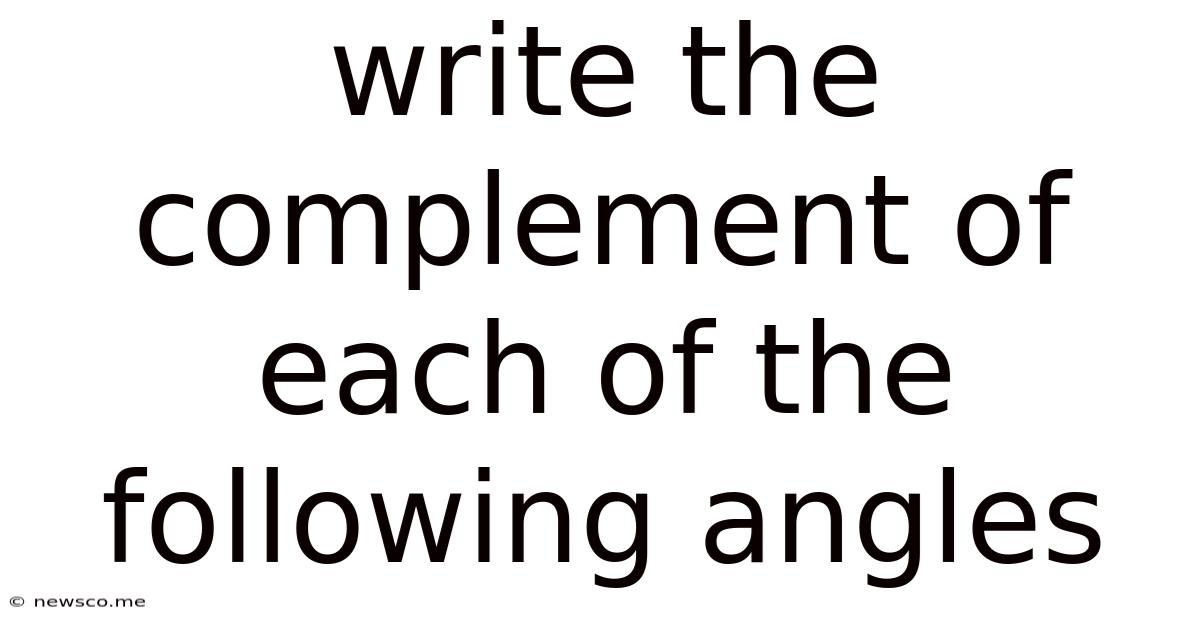Write The Complement Of Each Of The Following Angles
News Co
Apr 17, 2025 · 4 min read

Table of Contents
Understanding and Calculating the Complement of Angles
This comprehensive guide dives deep into the concept of complementary angles, exploring their definition, properties, and how to calculate the complement of various angles. We'll cover numerous examples and scenarios to solidify your understanding, making this a valuable resource for students and anyone seeking to improve their geometry skills.
What are Complementary Angles?
In geometry, complementary angles are two angles whose measures add up to 90 degrees (a right angle). It's crucial to remember that these angles don't have to be adjacent (next to each other); they simply need to sum to 90°. This simple definition forms the foundation for understanding and solving problems involving complementary angles.
Think of it like this: imagine a right-angled triangle. The two angles that are not the right angle are always complementary. This is a visual representation that can help solidify the concept.
Key Characteristics of Complementary Angles:
- Sum is 90°: The fundamental property. The sum of the measures of the two angles must equal 90°.
- Not necessarily adjacent: They can be separate angles that, when added together, result in 90°.
- Can be acute: Complementary angles are always acute angles (less than 90°). If one angle is obtuse (greater than 90°), it cannot have a complement.
Calculating the Complement of an Angle
Finding the complement of an angle is straightforward: simply subtract the given angle's measure from 90°. The result is the measure of its complementary angle.
Formula:
Complement = 90° - Angle
Let's illustrate this with some examples:
Example 1: Find the complement of a 30° angle.
Complement = 90° - 30° = 60°
Therefore, the complement of a 30° angle is a 60° angle.
Example 2: Find the complement of a 45° angle.
Complement = 90° - 45° = 45°
In this case, the complement of a 45° angle is also a 45° angle. This illustrates that an angle can be its own complement.
Example 3: Find the complement of a 15° angle.
Complement = 90° - 15° = 75°
Example 4: What is the complement of an angle measuring x degrees?
Complement = 90° - x°
This demonstrates the general formula for finding the complement of any angle represented by a variable.
Complementary Angles in Different Contexts
Complementary angles appear frequently in various geometric contexts:
- Right-angled Triangles: As mentioned earlier, the two acute angles in a right-angled triangle are always complementary.
- Squares and Rectangles: The angles at each corner of a square or rectangle are right angles (90°), formed by two complementary angles of 45° each.
- Coordinate Geometry: Understanding complementary angles is crucial when working with angles in the Cartesian coordinate system.
- Trigonometry: The trigonometric functions (sine, cosine, tangent) are closely related to the angles of a right-angled triangle, which inherently involve complementary angles.
Solving Problems Involving Complementary Angles
Let's delve into some more complex problems involving complementary angles:
Problem 1: Two angles are complementary. One angle is twice the measure of the other. Find the measure of each angle.
Let x be the measure of the smaller angle. The larger angle is 2x. Since they are complementary:
x + 2x = 90°
3x = 90°
x = 30°
The smaller angle is 30°, and the larger angle is 2 * 30° = 60°.
Problem 2: The measure of one angle is 10° less than its complement. Find the measure of each angle.
Let x be the measure of the angle. Its complement is 90° - x. We are given that:
x = (90° - x) - 10°
2x = 80°
x = 40°
The angle is 40°, and its complement is 90° - 40° = 50°.
Problem 3: Three angles, A, B, and C, are complementary. Angle A is twice angle B, and angle C is 15° more than angle B. Find the measures of A, B, and C.
Let B = x. Then A = 2x and C = x + 15°. Since they are complementary:
A + B + C = 90°
2x + x + x + 15° = 90°
4x = 75°
x = 18.75°
Therefore, B = 18.75°, A = 2 * 18.75° = 37.5°, and C = 18.75° + 15° = 33.75°.
Advanced Concepts and Applications
The concept of complementary angles extends beyond basic geometry. It's used in:
- Engineering: Calculating angles in structural designs, mechanical systems, and architectural blueprints often requires understanding complementary angles.
- Computer Graphics: In 3D modeling and animation, complementary angles play a role in defining rotations and orientations of objects.
- Navigation: Determining bearings and directions often involves working with angles, including complementary angles.
Conclusion
Complementary angles are a fundamental concept in geometry with widespread applications across various fields. Mastering the ability to identify and calculate complementary angles is essential for success in mathematics and related disciplines. Through consistent practice and a solid understanding of the principles outlined in this guide, you'll build a strong foundation in geometry and enhance your problem-solving abilities. Remember, the key takeaway is that two angles are complementary if their sum is 90°. With this knowledge, you can confidently tackle a wide range of geometry problems involving complementary angles.
Latest Posts
Related Post
Thank you for visiting our website which covers about Write The Complement Of Each Of The Following Angles . We hope the information provided has been useful to you. Feel free to contact us if you have any questions or need further assistance. See you next time and don't miss to bookmark.